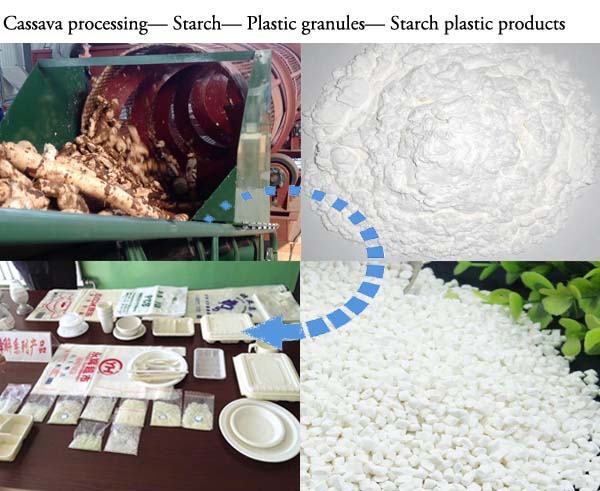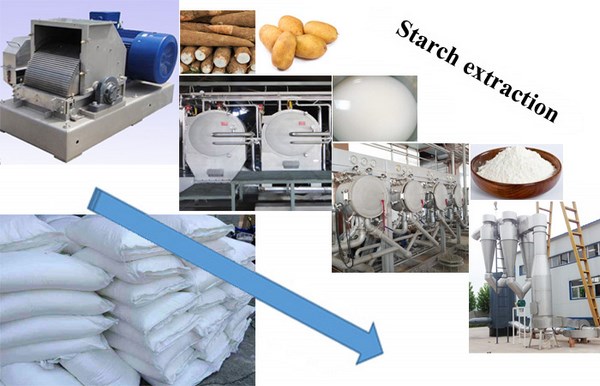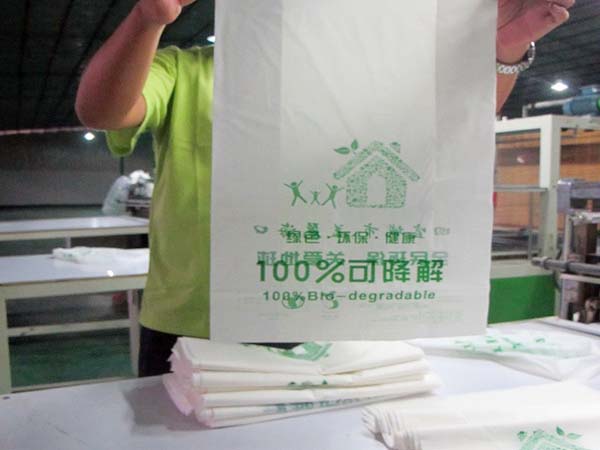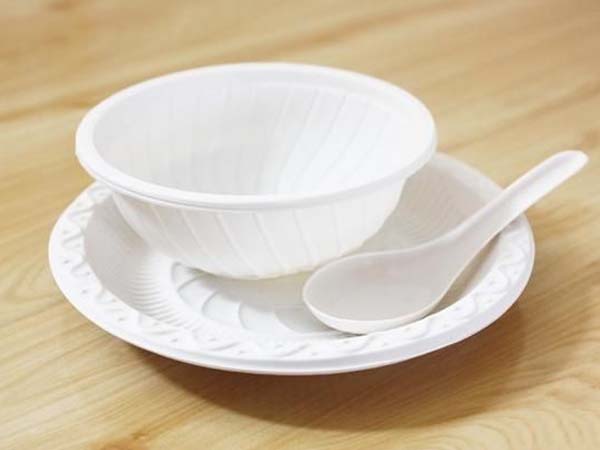Cassava starch in making biodegradable plastic
At present, countries around the world are competing to develop and apply the technology of cassava starch in making biodegradable plastic. For example, the United States, Japan, Germany, etc. have successively formulated regulations restricting or disabling non-degradable plastics. Many countries have also developed research and development plans for degradable plastics. Measures, invested a lot of manpower and material resources to develop a variety of truly degradable plastics, so the development of degradable plastics has developed rapidly in these areas, the annual growth rate in North America and Europe are: 17%, 59%, completely The use of degradable plastics undoubtedly promotes a virtuous cycle of the environment.
With the rapid development of the plastics industry, plastic products have been widely used at one time, causing serious pollution to the environment, because plastics are not easily decomposed and difficult to recycle, and plastic waste becomes harmful waste that pollutes the environment, on soil, ocean and air. The pollution is huge, leading to the consequences of destroying the ecological balance. The small plastic bag that is popular all over the world, although it is not fashionable, but because it is easy to use and low in price, it is almost everywhere and has become the world's largest source of white pollution.
 Cassava starch in making biodegradable plastic uses
Cassava starch in making biodegradable plastic uses
The plastics industry is based on petroleum resources, and by the first half of the 21st century, oil and natural gas will face a dilemma that may be exhausted. It is possible that the plastics industry is also facing a shortage of raw materials. Therefore, more and more scholars advocate the development and application of fully degradable plastics. Because fully degradable plastics have complete degradation ability, they will not bring harmful products after degradation, and will not cause pollution to the ecological environment. Moreover, fully degradable plastics also include a natural polymer degradable plastic, which is agricultural and sideline products. As a source of raw materials, agricultural and sideline products are sources of abundant and inexhaustible renewable resources. The raw materials for the complete degradation of plastics are mainly starch made from corn, soybeans, potatoes, cassava, platycodon, and the right amount of polyvinyl alcohol, glycerin, core additives, etc., to produce pellets of “completely biodegradable plastics”. The production of various plastic products directly from pellets, the production process is basically produced according to the original processing equipment of the plastics enterprise, and will not impact the original production structure.
It is worth mentioning that since cassava is produced in the tropics, it can be planted and harvested all year round, and the cost is low. Therefore, more and more people are paying attention to the application of cassava starch in the manufacture of biodegradable plastics.
Fully biodegradable plastics prepared by blending biodegradable polymers with starch, cellulose and lignin in cassava, as well as chitosan, glucosamine, animal glue and marine algae in animals, such as starch-polyvinyl alcohol, starch-aliphatic polyester, starch-polylactic acid, and starch-polybutylene succinate, etc., for another, cassava starch has better stability, color is white and has no odor, so cassava starch in making biodegradable plastic are more economical than other types of starch.
 Cassava starch processing
Cassava starch processing
According to the statistics of the China Plastic Products Quality Supervision and Inspection Center, the complete degradation rate of plastic products made of cassava is six times that of international standards. Energy saving is more than 100 times that of all petrochemical plastics, and there are special effects to improve the soil. Cassava starch produces waste after crushing can also be used as raw material for animal feed and organic fertilizer.
Biodegradable plastics have the following characteristics: (1) can return compost to nature; (2) reduce volume after degradation, save land occupied by landfills, and save land resources; (3) reduce incineration of harmful gases without incineration; (4) reduce the harm of random disposal of plastic bags to wild animals; (5) cassava starch made biodegradable plastic can be applied not only in daily life but also in the field of medicine.
Starch-based biodegradable plastics can be divided into three categories: starch-filled plastics, starch blended plastics, and all-starch plastics. At present, although there are many starch-based degradable plastics, there are still some problems such as cost and performance.
1. Price: Degradable plastics are more than 15% higher than ordinary plastic products, and the price of plastics that can be completely degraded is 4~10 times higher than the price of similar plastic products, which is difficult to promote. If the plastic products made from cassava starch want to be widely promoted, the most important thing is to be competitive in performance and price. Only in terms of performance and price exceed traditional plastics, the biodegradable plastic made from cassava starch will be recognized. Therefore, at present, it is only in some high-end cosmetic packaging containers and medical treatments has a small amount of applications can completely degrade plastics.
 The biodegradable plastic bags making from cassava starch
The biodegradable plastic bags making from cassava starch
2. Degradation performance: The degradation is not thorough and will still cause environmental pollution. The main components of filled and double-degradable plastics are synthetic resins, so they can only be incompletely degraded. As a result of the degradation, the overall mechanical properties of the material are greatly reduced and collapse into fragments or grid-like structures, and the fragments are more difficult to collect and process. For example, it is used in agricultural film, and the polyolefin product remains in the soil, and long-term accumulation will cause a large reduction in agricultural production. In addition, studies on the induction period control and degradation rate of double-degraded starch plastics and whole starch plastics are not satisfactory.
3. Scope of application: At present, the application range of starch plastic is narrow. Now the mechanical properties of starch plastics have basically reached the standard of traditional plastics, but because of the water absorption of starch itself, in the humid environment, the moisture absorption of the material causes serious mechanical properties drop, and the higher the amount of starch, the more serious the problem. Some starch plastics are even completely soluble in water, so their applications are limited.
 Cassava starch made tableware
Cassava starch made tableware
The 21st century is a century of sustainable development. The development of starch-based plastics can alleviate the current environmental pollution caused by plastic products and the problem of oil depletion. Among the starch-based biodegradable plastics, the whole starch biodegradable plastic has great development prospects, and can satisfy the production processes of different functional products, such as lunch boxes, agricultural films, medical supplies, and the like. It is a new type of production that replaces non-renewable resources, greens the environment, simplifies the process, and reduces costs. Although starch-based biodegradable plastics still have various problems and disputes, its development is in the ascendant, and research on whole starch plastics (thermoplastic starch plastics) may be strengthened in the future, and molecules are passed according to different uses and environmental conditions. Design, improve formula, develop and control plastics in a timely and controllable environment, actively research and develop high-efficiency and cheap photosensitizers, oxidants, biological inducers, degradation promoters and stabilizers, etc., further improve the on-time controllability of degradation and rapid degradation after use. And completely degradable. I believe that with the continuous advancement of science and technology, these problems will be solved.
To sum up, among is the cassava starch in making biodegradable plastic introduction and analyze, Doing Company as a manufacturer and supplier of professional cassava starch production machines, will continue to pay attention to the cassava starch in making biodegradable plastic develop. In recent years, plastic products made from cassava starch have been used in many areas of China. In September in 2018, when our company organized a trip to Qingdao, China, the cassava starch plastic tableware was used in the restaurant, its appearance is white, very clean, no smel
Leave a message
- WhatsApp:
+8613526615783
- Email:
sales@doinggroup.com
- Tel:
0086 135 2661 5783
- Phone:
0086 371 5677 1822
- Skype:
elina881130
- Address:
No.133 Yaozhai Road, Jinshui District, Zhengzhou City, Henan Province, China
-
 Cassava chips processing machine shipped to Nigeria
Cassava chips processing machine shipped to Nigeria
-
 Factors affecting the price of cassava processing equipment
Factors affecting the price of cassava processing equipment
-
 How to starct cassava production and processing business in Nigeria ?
How to starct cassava production and processing business in Nigeria ?
-
 DOING cassava starch production line successfully delivered to Nigeria
DOING cassava starch production line successfully delivered to Nigeria
-
 Cassava peeling machine shipped to Nigeria
Cassava peeling machine shipped to Nigeria
-
 What are the advantages of automatic starch production line ?
What are the advantages of automatic starch production line ?
-
 Garri processing machines and their prices
Garri processing machines and their prices
-
 New cassava slicer machine are ready to ship to Nigeria
New cassava slicer machine are ready to ship to Nigeria
-
 How profitable is garri processing business in nigeria ?
How profitable is garri processing business in nigeria ?
-
 Factors affecting the price of garri processing machine
Factors affecting the price of garri processing machine
-
 What is high quality cassava flour, how to produce high quality cassava flour ?
What is high quality cassava flour, how to produce high quality cassava flour ?
-
 How to process cassava into cassava chips ?
How to process cassava into cassava chips ?
-
 Cassava starch manufacturing process
Cassava starch manufacturing process
-
 How to maintain cassava starch processing equipment ?
How to maintain cassava starch processing equipment ?
-
 How to extract cassava starch ?
How to extract cassava starch ?
-
 How to make cassasva starch?
How to make cassasva starch?
-
 Water, electricity, steam and land deploy in starch processing plant
Water, electricity, steam and land deploy in starch processing plant
-
 How profitable is cassava starch made?
How profitable is cassava starch made?
Leave a message

Tel/Whatsapp:
+8613526615783



